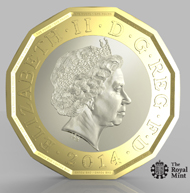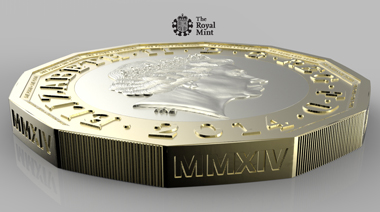April 8, 2014 – Starting in 2017, new GBP 1 circulation coins with improved security features using iSIS technology will be introduced in Great Britain in order to reduce counterfeiting. The precise specifications of the new coin will be decided this summer.
Prototype of the new GPB 1 coin. © Royal Mint.
On March 19, 2014, George Osborne, the Chancellor of the Exchequer said that HM Treasury believes there is a strong case for introducing a new GPB 1 coin to help reduce counterfeiting and ensure the integrity of the United Kingdom’s currency.
The Royal Mint has developed world-leading anti-counterfeiting technology which will enable Her Majesty’s Treasury to modernise the United Kingdom’s circulating currency with the production of a brand new GBP 1 coin. The Mint has produced a prototype for a replacement GPB 1 coin which utilises multiple layers of cutting edge technology and would allow the United Kingdom to rapidly reduce the rate of counterfeit coins entering general circulation.
Side-view of the prototype new GPB 1 coin. © Royal Mint.
The proposed GBP 1 coin will be the most secure circulating coin in the world to date.
A public consultation will be held over the summer focusing on how to manage any impacts before a final decision is made on the precise specification of the new coin, including the metal composition. The Royal Mint will work closely with key industry stakeholders to conduct a full consultation in order to understand the potential impact for industry.
A public design competition will be held at a later date to choose the design for the reverse, or “tails”, of the coin which is expected to be introduced in 2017.
The proposed GBP 1 coin design is distinctly British, with a twelve-sided shape which evokes memories of the pre-decimalisation threepence piece. It will be constructed from two different coloured metals and contain an iSIS security feature – a revolutionary new high security coinage currency system developed by The Royal Mint.
About iSIS
Using The Royal Mint’s aRMour® full-plate technology as its base, iSIS features security that until now has only been available in banknotes. Overt and limited covert security features have been available in coinage for some time, but, iSIS now lifts this covert security to banknote level. The highly secure technology that The Royal Mint has adopted in iSIS has been used in other industries, including banknotes, has now been successfully transferred to coinage for the first time.
ISIS can be authenticated via high-speed automated detection in cash centres and central banks and is harder to counterfeit and easier to detect than any coin before it. In addition, a new level of detection in vending machines will also be possible, creating a solid barrier to entry for counterfeits and therefore eliminating an important channel of entry into the cash cycle. The processes involved make iSIS extremely difficult to counterfeit. In fact, multiple third parties have attempted to reverse engineer the feature without success.
ISIS is not a surface coating, so will not wear off over time. As such, the coins will last around 30 years, lasting many times longer than an equivalent value banknote. Visually there will be no difference to normal coins as the iSIS feature is microscopically small. The difference comes from the fact that iSIS coins do not merely rely upon the metal composition to give a response to a sensor, but instead the presence of the iSIS material that gives extremely robust results throughout the typically long life of coins in addition to the parameters detected in today’s coins.
The Royal Mint’s Project iSIS received the 2013 Innovation Award from The Wales Quality Centre earlier this year. Read the CoinsWeekly article here.
You can visit the Royal Mint’s website for further information on counterfeit GPB 1 coins…
…or the history of Great Britain and its money on the beautifully set-up pages of the Royal Mint’s “Discover” section.






